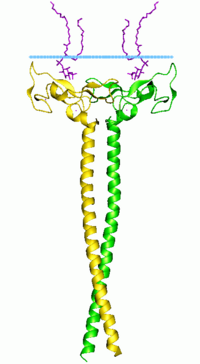| FYVE zinc finger | |||||||||
|---|---|---|---|---|---|---|---|---|---|
 | |||||||||
| Identifiers | |||||||||
| Symbol | FYVE | ||||||||
| Pfam | PF01363 | ||||||||
| InterPro | IPR000306 | ||||||||
| PROSITE | PDOC50178 | ||||||||
| SCOP2 | 1vfy / SCOPe / SUPFAM | ||||||||
| OPM superfamily | 59 | ||||||||
| OPM protein | 1vfy | ||||||||
| CDD | cd00065 | ||||||||
| |||||||||
In molecular biology the FYVE zinc finger domain is named after the four cysteine-rich proteins: Fab 1 (yeast orthologue of PIKfyve), YOTB, Vac 1 (vesicle transport protein), and EEA1, in which it has been found. FYVE domains bind phosphatidylinositol 3-phosphate, [2] in a way dependent on its metal ion coordination and basic amino acids. The FYVE domain inserts into cell membranes in a pH-dependent manner. [3] The FYVE domain has been connected to vacuolar protein sorting and endosome function. [4]
Structure
The FYVE domain is composed of two small beta hairpins (or zinc knuckles) followed by an alpha helix. [5] The FYVE finger binds two zinc ions. The FYVE finger has eight potential zinc coordinating cysteine positions and is characterized by having basic amino acids around the cysteines. Many members of this family also include two histidines in a sequence motif:
The FYVE finger is structurally similar to the RING domain and the PHD finger.
Examples
The following is a list of human proteins containing this domain:
- ANKFY1, EEA1, FGD1, FGD2, FGD3, FGD4, FGD5, FGD6, FYCO1, HGS, MTMR3, MTMR4, PIKFYVE, PLEKHF1, PLEKHF2
- RUFY1, RUFY2, RUFY3, RUFY4, WDFY1, WDFY2, WDFY3, ZFYVE1, ZFYVE9, ZFYVE16, ZFYVE19, ZFYVE20, ZFYVE21, ZFYVE26, ZFYVE27, ZFYVE28
References
- ^ Dumas JJ, Merithew E, Sudharshan E, et al. (November 2001). "Multivalent endosome targeting by homodimeric EEA1". Mol. Cell. 8 (5): 947–58. doi: 10.1016/S1097-2765(01)00385-9. PMID 11741531.
- ^ Gaullier JM, Simonsen A, D'Arrigo A, Bremnes B, Stenmark H, Aasland R (July 1998). "FYVE fingers bind PtdIns(3)P". Nature. 394 (6692): 432–3. doi: 10.1038/28767. PMID 9697764. S2CID 4385768.
- ^ He J, Vora M, Haney RM, et al. (September 2009). "Membrane insertion of the FYVE domain is modulated by pH". Proteins. 76 (4): 852–60. doi: 10.1002/prot.22392. PMC 2909462. PMID 19296456.
- ^ Leevers SJ, Vanhaesebroeck B, Waterfield MD (April 1999). "Signalling through phosphoinositide 3-kinases: the lipids take centre stage". Curr. Opin. Cell Biol. 11 (2): 219–25. doi: 10.1016/S0955-0674(99)80029-5. PMID 10209156.
- ^ Misra S, Hurley JH (May 1999). "Crystal structure of a phosphatidylinositol 3-phosphate-specific membrane-targeting motif, the FYVE domain of Vps27p". Cell. 97 (5): 657–66. doi: 10.1016/S0092-8674(00)80776-X. PMID 10367894. S2CID 15448444.
Further reading
- Stenmark H, Aasland R, Toh BH, D'Arrigo A (September 1996). "Endosomal localization of the autoantigen EEA1 is mediated by a zinc-binding FYVE finger". J. Biol. Chem. 271 (39): 24048–54. doi: 10.1074/jbc.271.39.24048. PMID 8798641.
- Stenmark H, Aasland R (December 1999). "FYVE-finger proteins--effectors of an inositol lipid". J. Cell Sci. 112 (Pt 23): 4175–83. PMID 10564636.
| FYVE zinc finger | |||||||||
|---|---|---|---|---|---|---|---|---|---|
 | |||||||||
| Identifiers | |||||||||
| Symbol | FYVE | ||||||||
| Pfam | PF01363 | ||||||||
| InterPro | IPR000306 | ||||||||
| PROSITE | PDOC50178 | ||||||||
| SCOP2 | 1vfy / SCOPe / SUPFAM | ||||||||
| OPM superfamily | 59 | ||||||||
| OPM protein | 1vfy | ||||||||
| CDD | cd00065 | ||||||||
| |||||||||
In molecular biology the FYVE zinc finger domain is named after the four cysteine-rich proteins: Fab 1 (yeast orthologue of PIKfyve), YOTB, Vac 1 (vesicle transport protein), and EEA1, in which it has been found. FYVE domains bind phosphatidylinositol 3-phosphate, [2] in a way dependent on its metal ion coordination and basic amino acids. The FYVE domain inserts into cell membranes in a pH-dependent manner. [3] The FYVE domain has been connected to vacuolar protein sorting and endosome function. [4]
Structure
The FYVE domain is composed of two small beta hairpins (or zinc knuckles) followed by an alpha helix. [5] The FYVE finger binds two zinc ions. The FYVE finger has eight potential zinc coordinating cysteine positions and is characterized by having basic amino acids around the cysteines. Many members of this family also include two histidines in a sequence motif:
The FYVE finger is structurally similar to the RING domain and the PHD finger.
Examples
The following is a list of human proteins containing this domain:
- ANKFY1, EEA1, FGD1, FGD2, FGD3, FGD4, FGD5, FGD6, FYCO1, HGS, MTMR3, MTMR4, PIKFYVE, PLEKHF1, PLEKHF2
- RUFY1, RUFY2, RUFY3, RUFY4, WDFY1, WDFY2, WDFY3, ZFYVE1, ZFYVE9, ZFYVE16, ZFYVE19, ZFYVE20, ZFYVE21, ZFYVE26, ZFYVE27, ZFYVE28
References
- ^ Dumas JJ, Merithew E, Sudharshan E, et al. (November 2001). "Multivalent endosome targeting by homodimeric EEA1". Mol. Cell. 8 (5): 947–58. doi: 10.1016/S1097-2765(01)00385-9. PMID 11741531.
- ^ Gaullier JM, Simonsen A, D'Arrigo A, Bremnes B, Stenmark H, Aasland R (July 1998). "FYVE fingers bind PtdIns(3)P". Nature. 394 (6692): 432–3. doi: 10.1038/28767. PMID 9697764. S2CID 4385768.
- ^ He J, Vora M, Haney RM, et al. (September 2009). "Membrane insertion of the FYVE domain is modulated by pH". Proteins. 76 (4): 852–60. doi: 10.1002/prot.22392. PMC 2909462. PMID 19296456.
- ^ Leevers SJ, Vanhaesebroeck B, Waterfield MD (April 1999). "Signalling through phosphoinositide 3-kinases: the lipids take centre stage". Curr. Opin. Cell Biol. 11 (2): 219–25. doi: 10.1016/S0955-0674(99)80029-5. PMID 10209156.
- ^ Misra S, Hurley JH (May 1999). "Crystal structure of a phosphatidylinositol 3-phosphate-specific membrane-targeting motif, the FYVE domain of Vps27p". Cell. 97 (5): 657–66. doi: 10.1016/S0092-8674(00)80776-X. PMID 10367894. S2CID 15448444.
Further reading
- Stenmark H, Aasland R, Toh BH, D'Arrigo A (September 1996). "Endosomal localization of the autoantigen EEA1 is mediated by a zinc-binding FYVE finger". J. Biol. Chem. 271 (39): 24048–54. doi: 10.1074/jbc.271.39.24048. PMID 8798641.
- Stenmark H, Aasland R (December 1999). "FYVE-finger proteins--effectors of an inositol lipid". J. Cell Sci. 112 (Pt 23): 4175–83. PMID 10564636.